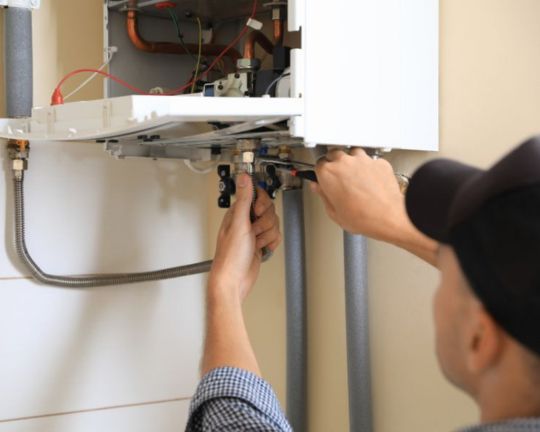Your boiler’s filling loop (or central heating filling loop, as it’s sometimes known) is an important bit of kit. But, if you’ve never heard of it before, don’t know what it is or where to find it, then this guide is for you.
Simply put, it’s a hose that connects your sealed central heating system to the mains water supply. It’s used to fill your heating system with water and maintain your boiler pressure if it’s dropped to below 1 bar, which can happen if you’ve recently bled your radiators, there’s a leak, or if there’s a fault within your boiler.
Find out more about what to do when your boiler pressure drops.
Different types of boiler filling loops
There are two main types of boiler filling loops – internal and external. Here we’re going to look at what the differences are and how they work.
External filling loop
As its name suggests, this is attached and connected outside of your boiler to help repressurise it.
It’s the most common type of filling loop and features a braided hose with two valves – one for controlling the flow of the water and the other to stop water from flowing back into the mains. It’s really important that this is fitted the right way to avoid chemicals from your central heating flowing into the mains water.
Internal filling loop
These are often found in combi boilers and are a little more complex in their structure because they’re built into the boiler itself.
Again, there are two valves – one connects to the boiler whilst the other connects to the mains water supply. There’s also a stop valve which controls the water flow and a double-check valve which stops water flowing back into the mains.
Where is the filling loop on my boiler?
Regardless of whether your boiler has an external or internal filling loop, you’ll often find it near the pipework, directly underneath your boiler.
However, just be aware that an external loop can be located anywhere on your central heating circuit, so you may find it a little further away from the boiler, although generally never more than 1 metre away.
If at this point you’d like to know more about your central heating, check out our guide on how your central heating system works.
How to use a boiler filling loop
The exact process of using a filling loop depends on whether it’s internal or external…
How to use an internal boiler filling loop
- First of all, turn off your boiler and leave it for around 20 minutes to cool down.
- Locate the filling key. Some models have a tray below the boiler, but this may also be included in a pack with your boiler manual.
- This step may vary according to your boiler, so be sure to consult your boiler manual. For some models, you turn the key from the open position to the closed padlock symbol, then turn the knob beside it anticlockwise to top up the water.
- You’ll see the pressure gauge start to move – wait until it reaches between 1 and 1.5 bars, then turn the key backwards to tighten and unlock the key.
- Put the key back where you found it or in a safe and memorable location.
How to use an external boiler filling loop
- First of all, turn off your boiler and leave it for around 20 minutes to cool down.
- You may find that you don’t have a filling loop connected. Grab your filling loop if you have one and make sure it’s in good condition.
- Make sure any valve taps on your filling loop are in the closed position (horizontal or across the pipe).
- Unscrew any valve caps from the boiler and mains water pipe (if they have any).
- Connect the ends of the filling loop to the mains water and boiler pipe by tightening the nuts and ensuring a good seal. Always check your boiler manual to make sure you’re attaching it correctly.
IMPORTANT: Make sure that the stop valve is attached to your heating system, as this will allow water to flow in and out of your boiler. Then the double-check valve should be connected to the mains water pipe to prevent any water from going back up into it.
- Using the taps on your filling loop, open both valves so they’re in line with the pipe – you’ll hear the water start to flow into your system.
- Watch the pressure rise to between 1 and 1.5 bars, then close the valves.
- Remove the boiler filling loop and keep it in a safe place. Be aware there’ll be a small amount of water left in the filling loop tube.
- Turn your boiler back on.
Keep your boiler running smoothly with HomeServe
If you find that you need to repressurise your boiler more often than usual then it could be due to an issue with your boiler, so make sure you take a look at our handy guide to diagnosing common problems.
We’ve even created a list of repair costs so, depending on what needs fixing, you can get a good idea of how much it’s likely to set you back.
Should you need an extra helping hand, we’ve got Gas Safe registered engineers nationwide, ready to help to make sure your boiler is always running at its best. Whether you choose to protect it with boiler cover or you just want peace of mind, an expert is nearby for those one-off repairs – you can always count on us.
